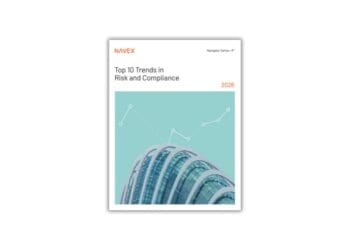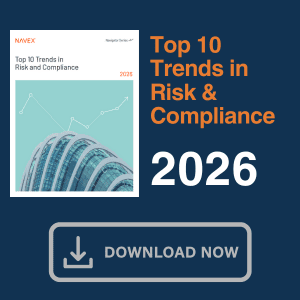As past and current events continue to remind us, disruptive change is a reality. Protiviti’s Jim DeLoach examines new global research revealing that while disruption is universally recognized, organizations respond from radically different positions.
In Protiviti’s second annual global board governance survey report, conducted with BoardProspects and Broadridge Financial — over 75% of more than 1,800 board members and C-suite executives noted that their organizations expect major business model changes within three years. In a recent webinar, my colleague, Frank Kurre, asked the over 700 participants for similar feedback and a higher percentage (82%) responded the same.
Our survey also revealed that only 15% of organizations consider themselves to be disruptive leaders in transforming their industry or creating a new industry. Our webinar participants reported a lower percentage — 14%.
These and other results suggest that as far as the speed and impact of disruptive change accelerating are concerned, most everyone gets it. As markets evolve, so must companies. It’s the law of the competitive jungle: Disrupt or be disrupted.
The disruption continuum
No company can claim immunity to some form of disruption. For example, the recent “reciprocal tariffs” levied by the US are highly disruptive to many companies’ supply chains. So was the Covid-19 pandemic. However, just as some companies managed the impact of the pandemic on their operations better than others, such will also be the case in the present chaotic trade environment.
With this hypothesis that not all companies are alike, we introduced a disruption continuum consisting of five levels of maturity — disruptive leaders, disruption aspirants, vulnerable disrupters, agile followers and disruption laggards. We then invited our global survey respondents to indicate their organizations’ position on this continuum. The survey found that almost 50% of companies identify themselves as at risk of disruption.
Disruptive leaders transform industries with innovative solutions, business models and customer experiences. They create sustainable business models with strong economic moats that enable them to protect their market share and profitability through unique offerings, financial strength, talent access, scale, brand differentiation, low-cost positioning and high switching costs. Achieving this advantage requires vision, an aligned culture, capital investment and some luck. Disruptive leaders challenge and displace incumbents, transforming customer experiences. Examples include Amazon, Netflix, Uber and Airbnb, as well as Apple’s introduction of the iPod and iPad.
There are two other categories of disrupters — disruption aspirants and vulnerable disrupters.
Disruption aspirants view themselves as disrupters and are making progress at becoming more disruptive. They are proficient in disruptive innovation but are not recognized by the market as disruptive leaders. It takes time, capital and patience to build the foundation to become a disruptive leader. Today’s undisputed global leader in chipmaking, Nvidia, required many years to acquire and develop the foundational elements on which its present GPU product offerings are based. The company’s patent portfolio covers a wide range of technologies, ensuring that every component of its AI-optimized GPUs remains proprietary.
Vulnerable disrupters view themselves as disrupters but are also at risk of being disrupted — a paradox of sorts that highlights the dynamic and often precarious nature of innovation and market leadership. These companies are equipped to compete and adapt to changes in the market, but their vulnerabilities necessitate a proactive approach to anticipating potential threats posed by innovative competitors or other emerging disruptive forces. They must innovate constantly and sustain relationships with key alliance and ecosystem partners to maintain their edge and market positioning.
Agile followers are at risk of being disrupted but are quick to pivot and adapt. They respond to sudden, high-velocity events as well as recognize disruptive trends early and pivot decisively in response to these trends. They choose not to assume the risk profile of a company pursuing first-mover advantage. Instead, they opt to wait and see regarding trends and solutions that interest them and learn from the mistakes of first movers, refine their offerings and potentially enter the market with a more mature and competitive product or service.
Apple’s iPhone launch in 2007 and Google’s Android launch in 2008 are examples of “second-mover advantage,” as they disrupted the mobile phone market, leading to the downfall of incumbents like Nokia, Blackberry, Palm and Sony Ericsson. Thus, agile followers can compete, win and sustain relevance by responding to market developments and leapfrogging first movers that fail to adapt to changing user preferences. Apple’s success with various products shows that companies with disruptive leader attributes can also choose to be effective agile followers.
In addition to being at risk of being disrupted, disruption laggards are slow to evaluate how to react and respond. This is not the preferred profile in an environment of rapidly changing markets. Think Blockbuster, Borders and Sears.
Our survey noted that 15% and 34% of the respondents categorized their organizations as disruptive leaders and disruption aspirants, respectively. In addition, 25% and 16% categorized their companies as vulnerable disrupters and agile followers, respectively. Finally, 7% were disruption laggards and 3% indicated “Not sure.”
When the Ink Dries: 6 Critical Post-Transaction Areas That Make or Break M&A Success
Poor follow-up once the deal is closed can cause culture clashes & value erosion
Read moreDetailsChange is the norm
The half-life of organizational business models is shrinking. Companies arrayed across the disruption continuum expect their business models to undergo moderate to significant changes within the next 36 months. Market factors like technological advances, geopolitical shifts, evolving customer experiences, regulatory changes, economic volatility and disruptive innovations are driving companies to modify their business models more frequently than ever to sustain their competitive position and relevance.
In this environment of changing business realities, not everyone can be a leader. Furthermore, as noted earlier, not everyone wants to be a leader. Companies are different. Agile followers can successfully navigate disruption by leveraging their strengths and embracing innovation with a strong customer focus in responding to disruptive change driven by leading market players. However, every organization can learn from what disruptive leaders do differently.
Disrupters are more confident in their resiliency
Confidence in a company’s agility to respond to changing markets varies. For example, an organization’s perceptions of its level of resilience and ability to respond timely to market disruptions are shaped by how it views itself as either a disrupter or a business subject to disruption. From their agility and innovative culture to their views on external factors that can disrupt the enterprise, disruptive leaders are better prepared to embrace change. On the flip side, organizations that classify themselves as at risk of being disrupted view their organizations as less agile and see talent and culture as barriers to anticipate and stay ahead of waves of disruptive change.
Disrupters focus on differentiators that matter
In creating and shaping disruption, the key areas of focus for disruptive leaders are:
- Delivering superior customer experiences through business model innovation.
- Building superior infrastructure and capabilities to scale new products.
- Differentiating market offerings through significant pricing or quality advantage.
Disruptive aspirants share these top three areas of focus, though they rank differentiating market offerings ahead of building superior infrastructure and capabilities. Disruptive leaders introduce novel solutions significantly different and more robust than what currently exists and often target underserved or new markets, gradually improving their offerings and scaling their operations to attract mainstream customers. They are relentless in focusing on the customer and do not permit an inward-looking obsession with process or functional excellence to obscure that focus.
Disruptive leaders are committed to technology modernization
All survey respondents, regardless of their organization’s disrupter status, rate the accelerating pace of technological advancement as their most significant concern in terms of external factors that may disrupt the company’s strategy and business model. Whether an organization leverages technological disruption as an opportunity or scrambles to mitigate its negative effects depends heavily on the sophistication and agility of its technology environment.
Views on the pace of the organization’s technology modernization efforts are telling. Among disruptive leaders, a strong majority (72%) have a high level of confidence that they are modernizing their technology infrastructure at a sufficient pace to address disruption risk, vs. 37% of all other organizations. For disruption laggards, this level of confidence percentage is a mere 12%. This is a differentiating factor that cannot be ignored in a disruptive world.
As a sidelight, technical debt is the cost and magnitude of additional rework caused by the cumulative effect of choosing technology solutions that are easier to implement over the near term rather than the best overall solution for the long run. Disruption laggards are more than twice as likely as disruptive leaders to view excessive technical debt from legacy technology infrastructure as the most significant barrier to responding to disruption in an agile manner.
Disruptive leaders view generative AI as an opportunity
Generative AI is a disruption in which outsized impacts swing from game-changing to extremely damaging, depending on an organization’s perceived disruption status. Most disruptive leaders (72%) approach and leverage generative AI as an opportunity, while more than two in five agile followers and disruption laggards, as a group, view generative AI as a substantial threat to their business.
The adoption and operationalization of generative AI tools now yield major productivity improvements as new forms of agentic AI (AI systems that go beyond responding to individual queries to analyze challenges, develop strategies and execute high-volume tasks simultaneously without continuous human intervention) appear poised to deliver even more sweeping value. This combination of opportunity and risk makes it an imperative for the board and the C-suite to devote sufficient time and attention to disruption risk while fast-tracking the integration of technology with the appropriate risk governance and enterprise risk management programs.
Talent and a resilient culture are key differentiators
For disruptive leaders, the perceived market barriers to advancing their disrupter agenda or responding agilely to disruptive events are regulatory constraints along with capital and/or resource constraints for research and development. But it’s a different story for disruption laggards. For them, lack of an innovative culture or the talent needed to stimulate creative thinking, as well as resistance to change within the organization, are the top barriers.
These results reveal stark differences between disrupter organizations and those susceptible to being disrupted. Consider the innovative culture barrier, for example. Half of disruption laggards (50%) view this as a significant barrier to agility and disruption, vs. just one in 10 (11%) disruptive leaders. There is a similar disparity in the responses related to organizational resistance to change.
Bottom line, the keys to being a disrupter and having the capability to respond agilely to market events lie in talent, culture and embracing change. This point is important to keep front and center as directors and senior executives focus on the quickening pace of change and the unique organizational disruption risks that accompany it.
Summary
Our survey results offer insights regarding certain characteristics distinguishing organizations along the disruption continuum, including comparison of disruptive leaders with all other organizations. Because it is not possible for everyone to be a disruptive leader, we are not suggesting that all organizations need to be alike. As we noted earlier, agile followers can be successful if they make good data-driven decisions and pivot timely.
A company’s susceptibility to being disrupted depends on how vulnerable it is to potential change or disruptive market forces. In today’s optics, clinging to the status quo is dangerous. Since everyone can learn from what leaders do, we recommend that organizations take a pause and consider opportunities to improve how they manage inevitable change in the marketplace, both as an opportunistic disrupter as well as an agile responder to disruptive trends and events.
We encourage everyone to review our global survey. It includes relevant questions for directors and senior executives to consider based on the survey’s key takeaways. The questions are organized in several categories, consistent with our presentation of the survey findings:
- The strategy and business model.
- AI and other technologies.
- Technology modernization.
- Barriers to being a disrupter and responding to disruption.
- Agility and resilience in responding to disruption.
The questions emphasize the changing business realities that require senior executives and directors to stay closely connected to the marketplace; recognize when change is necessary based on reliable, insightful data; and act decisively to drive the necessary change within their organizations in a timely manner. We hope that our research will stimulate leaders’ thinking as they assess the competitive landscape, potential disrupters and their desired positioning on the disruption continuum.




 Jim DeLoach, a founding
Jim DeLoach, a founding 





